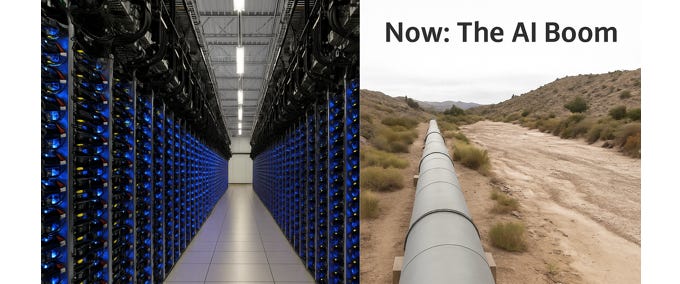C&C. THIRSTY. Its Official: They Did It.
August 2 | Posted by mrossol | AI, Childers, Democrat Party, Environment, Hillary Clinton, Intelligence ServicesWell, one more BIG issue with AI. Water. But like Childers says, it’s likely unstoppable. The opportunity is to minimize the damage as much as we can. mrossol
Source: THIRSTY ☙ Saturday, August 2, 2025 ☙ C&C NEWS
WORLD NEWS AND COMMENTARY
🔥🔥🔥
Your AI chatbot is very thirsty. This week, the Economic Times of India ran a story headlined, “Texas AI centers guzzle 463 million gallons, now residents are asked to cut back on showers.” The sub-headline noted, “Amidst severe drought in Texas, a clash emerges as AI data centers consume millions of gallons of water daily.”
In a state so dry it’s cracking, the real moisture vampires aren’t farmers or even the climate— it’s Big Tech. Texas data centers, led by Microsoft and the U.S. Army Corps in San Antonio, guzzled a staggering 463 million gallons of water over two years, all while locals were fined for watering their lawn more than once a week. And that’s just a sip. The state projects 49 billion gallons will be drained by Lone Star server farms this year alone, enough to hydrate millions of households— except, of course, it will be sacrificed to the small-‘g’ gods of AI.
It’s a problem. We can fast-track nuclear reactors to solve the power problem. But where will inland AI data centers get all the water? The most obvious solutions are expensive and time-consuming. Think building long-distance desalination pipelines between Corpus Christi and Austin, or inventing new cooling technologies that don’t need as much H2O.
🔥 That’s all very problematic and meme-worthy, but let’s zoom out and admire the bigger picture: AI has become a manifest destiny for the digital age. And, like every historical land rush, it’s flattening everything in its path: environmental safeguards, zoning laws, water rights, and even democratic input.
AI doesn’t live in “the cloud.” It lives in a factory— one that eats electricity, water, and land like a steel mill on Adderall. Each chatbot reply to a dumb question and each AI image of a cat on ice skates costs more water than flushing a toilet, and more power than you’d care to know. Multiply that by billions of queries. Now multiply that by every government and corporation on Earth trying to automate everything, all at once.
Over the last several weeks, President Trump has signed a slew of executive orders amounting to a national emergency, or a new Manhattan Project, to build out the nation’s AI infrastructure at Warp Factor Six. Every nation on Earth sees the race to AI dominance as both an economic and a military imperative. Being left behind is politically inconceivable.
AI is now a national security priority on par with nukes and space dominance.
There’s no cloak-and-dagger secrecy here. It’s out in the open. It’s mobilization. Trump’s orders read less like stale bureaucratic white papers and more like wartime directives. They name America’s adversaries, list supply chain chokepoints, and explicitly state that losing the AI race would cripple U.S. global power. It’s open-air strategic escalation, visible for anyone who cares to read.
🔥 It is pointless to dwell on the shoulds and shouldn’ts. It is happening. And it’s happening fast, whether anybody likes it or not. Even influential AI developers like OpenAI’s CEO Sam Altman publicly muse about being terrified where we’re headed, but then just shrug and get back to work. Tom’s Guide, this week:
The reason AI can’t be stopped is brutally simple: constraining AI development in any way is akin to unilateral disarmament. If America hits the brakes, the thinking goes, China, Russia, India, and every other would-be superpower will simply surge ahead. And whether that’s objectively true or not almost doesn’t matter— because everyone believes it, which makes it functionally true. That belief alone fuels a new space race, flattens NIMBY resistance, and overrides ordinary caution.
The Manhattan Project is a tempting comparison, but it’s too singular, secretive, and compartmentalized. If we’re analyzing the AI surge as an unstoppable political, economic, military, and cultural force, the better historical template isn’t a one-time wartime burst of effort. It’s a dynamic fusion of three epoch-shaping transformational periods:
- The railroad boom of the 1860s–1890s, with its ruthless land grabs, government subsidies, monopolistic empires, and permanent reshaping of geography.
- The personal computing revolution of the 1970s–1990s, which started in garages and ended up on every desk— eventually in every pocket … and soon, right in your cerebral cortex.
- The nuclear arms race (1945-1980ish), where existential risk, national pride, and accelerationist logic shifted governments into rarely used higher gears.
If you cram all three of those transformative technological revolutions into a single Rubik’s Cube and spin it, you get a more complete analogy for today’s AI experience. It isn’t just a moment. It is a headlong, all-in national sprint to build, dominate, and deploy world-shaping infrastructure under the banner of inevitability. This time, the rails are digital and global, the warheads and satellites are algorithms, and the end user is everyone.
The 19th-century railroad boom consumed vast quantities of coal and steel. Similarly, the AI boom runs two different elemental resources: power and water. Our new digital rails may be invisible, but they also demand physical infrastructure— in AI’s case, megawatts of uninterrupted electricity and billions of gallons of water to cool the infernal servers.
And just like in the late 1800s, when railroads carved across the country using eminent domain, government subsidies, and politically greased land grants, today’s AI empires are laying down tracks through neighborhoods, farmland, and aquifers. Only now, the locomotives run on computer chips and the cargo is your late-night web-surfing history.
In Texas, data centers are already consuming more water than many cities. Pipelines are being feverishly imagined. Rivers are being jealously eyed. Rural aquifers are being drained. And unlike electricity —which regulators can at least throttle during grid emergencies— there are no meaningful legal constraints on how much water a server farm can gulp. The law is twenty years behind the machine.
This isn’t any manifesto for halting the AI revolution. That ship has not only sailed, it’s laying undersea cable and mining the ocean floor for rare earths. What matters now is how we mitigate the harms, distribute the costs, and preserve local autonomy, human dignity, and ecological sanity. We may not be able to stop the engines, but we still have time to build guardrails, establish break zones, and install escape hatches— if we act intentionally and thoughtfully.
Progress, as always, is a freight train. Moving farther away from the station, or laying down in front of the train may be principled responses, but they aren’t productive. The better strategy is to get on board, find the conductor, and start negotiating, before the route is locked in and we’re railroaded onto a human reservation, waving at our water supply in the rearview.
Tl;dr: The AI age is coming fast. The question isn’t whether we stop it. The question is whether we matter in it.
🔥🔥🔥
Now, for some Quick Takes on breaking news.
— New York Times, yesterday: “Switzerland Is Stunned by 39% U.S. Tariff, Among the Highest in the World.” My take: I’m not sure why the Swiss are surprised; Switzerland is the international HQ for the World Economic Forum in Davos. Tell Klaus we said, ‘bye, Felicia.’
— This week, the New York Times ran a full-form, multi-media, movie-style article headlined, “How Louisiana Built Trump’s Busiest ICE Deportation Hub.” My take: Great job, cajuns, but Alligator Alcatraz is creeping up right behind you.
— CBS, yesterday: “Corporation for Public Broadcasting, funder of NPR and PBS, says it will end operations within months after federal budget cuts.” My take: NPR and PBS, now on their own, are in a branding trap they made for themselves. Their audience expects a far-left editorial tilt; listeners won’t tolerate moderation. Honestly? NPR’s best bet is to double down on its blatant bias.
— Yesterday, Secretary Kennedy announced that HHS and CMS Director Mehmet Oz repealed a long-standing Medicare reimbursement policy that financially incentivized hospitals to push covid shots. My take: I guess some people don’t like secret bribes for doctors to jam EUA drugs with no long-term safety data down patients’ throats. Weird. Something about “informed consent.” Dunno.
— Independent journalist Matt Taibbi, of “Twitter Files” fame, evaluated the new RussiaGate disclosures the same way I did: We now know how it all started. In yesterday’s Substack article titled, “No Doubt Left: Russiagate Was a Cover-Up,” Matt boiled it down like this:
One, Hillary Clinton and her team apparently hoped to deflect from her email scandal and other problems via a campaign tying Trump to Putin. Two, American security services learned of these plans. Three — and this is the most important part — instead of outing them, authorities used state resources to massively expand and amplify her scheme. The last stage required the enthusiastic cooperation and canine incuriosity of the entire commercial news business, which cheered as conspirators made an enforcement target of Trump, actually an irrelevant bystander.
Hillary Clinton got in trouble being dumb, tried to save herself by doing something dumber, and all of American officialdom backed the play. That’s it.
— On Thursday, the Washington Examiner ran a very encouraging story headlined, “Trump killing federal regulations at 10-1 rate, tops first term’s 4-1 cut.” And early last week, the Washington Post ran this even more exciting story: “DOGE builds AI tool to cut 50 percent of federal regulations.”
According to the story, DOGE’s AI estimated that 100,000 can safely be cut from 200,000 existing regulations “because they are no longer required by law.”
My take: Ten-to-one sounds great, don’t get me wrong, but how about 100-to-one? Cut, and keep cutting!
Have a wonderful weekend! Coffee & Covid —and its author— will be back in the digital saddle on Monday morning, with a fresh delivery of non-vacation essential news and commentary. See? That wasn’t so bad.
Don’t race off! We cannot do it alone. Consider joining up with C&C to help move the nation’s needle and change minds. I could sure use your help getting the truth out and spreading optimism and hope, if you can:☕ Learn How to Get Involved 🦠
How to Donate to Coffee & Covid
Twitter: jchilders98.
Truth Social: jchilders98.
MeWe: mewe.com/i/coffee_and_covid.
Telegram: t.me/coffeecovidnews
C&C Swag! www.shopcoffeeandcovid.com










Leave a Reply
You must be logged in to post a comment.